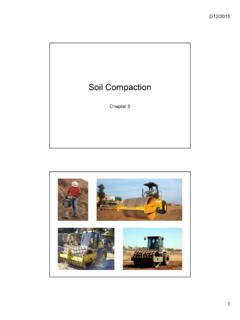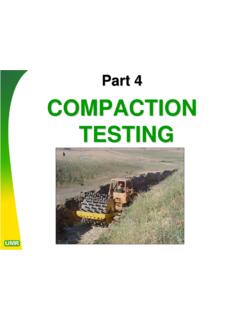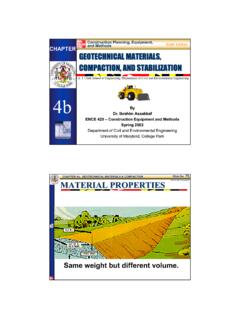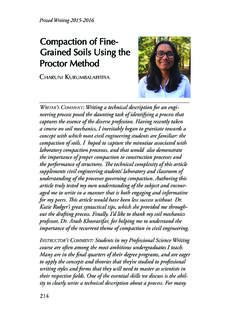Transcription of Recommended Compaction Requirements for Placement …
1 Project Summary Report 1874-S 1 The University of Texas at AustinCenter forTransportation Research PROJECT SUMMARY REPORTCENTER FOR TRANSPORTATION RESEARCHTHE UNIVERSITY OF TEXAS AT AUSTINP roject Summary Report 1874-SAssessment of Cohesionless Materials to Be Used as Compacted FillAuthors: Stephen G. Wright, Brad J. Arcement, and Eric R. MarxRecommended Compaction Requirements for Placementof Uniform Fine Sand Backfill MaterialsObjective and Scopeof ProjectThe objective of thisproject was to developrecommendations for com-paction of cohesionless soilsused as backfill Texas Department ofTransportation (TxDOT)utilizes a number of sourcesof cohesionless soils as fillmaterials for embankmentconstruction and as backfillfor mechanically stabilizedearth (MSE) walls. Someproblems have been experi-enced with these materials inthe past, especially withsettlements of backfillsbehind retaining sought a suitableprocedure for Placement ofthese materials that wouldensure satisfactory We of State Department ofTransportation CompactionRequirementsMost of the state depart-ments of transportation(DOTs) in the United Stateswere surveyed regarding theirrequirements for compactionof cohesionless fill attention was paidto the laboratory compactionprocedures used and thespecifications for of Soil for TestingTxDOT selected severalsources of cohesionless fillmaterials for testing andevaluation.
2 Initially, attentionwas focused on the El Pasoarea where abundant sourcesof cohesionless fill materialsare available and used. Ninesources of fill material wereidentified in the El Paso areaand samples were obtainedfor further laboratory the initial selection ofsoils from the El Paso area,the study scope was widenedto include soils from theHouston, Fort Worth, Beau-mont, Corpus Christi, andAustin regions. Fourteendifferent cohesionless fillmaterials were selected forstudy. Samples of each ofthese soils were obtained forfurther laboratory Testing ProgramLaboratory testing in-cluded basic index propertiesand grain size distribution forclassification of each of the soils were com-pacted using each of thefollowing Compaction proce-dures: TxDOT Tx 113-E-Laboratory CompactionCharacteristics andMoisture-Density Rela-tionship of Base Materials ASTM D 1557-Labora-tory Compaction Charac-teristics of Soil UsingModified Effort British Standard BS-1377-Vibrating HammerMethod ASTM D 4253-MaximumIndex Density and UnitWeight of Soils Using aVibratory TableAll tests using the Tx113-E procedure were per-formed using a specialhammer and neoprene padrecommended in the Tx 113-E test procedure for materi-als difficult to compact.
3 Forall soils compacted using theASTM D 4253 procedure, theminimum density was alsodetermined using the ASTMD 4254 test procedure (mini-mum index density and unitweight of soils, and calcula-tion of relative density). Themaximum and minimumdensities determined byProject Summary Report 1874-S 2 ASTM D 4253 and 4254 proce-dures were used to calculaterelative densities for the soilstested. In most cases, completemoisture-density curves wereobtained for each soil using thecompaction procedures size distributions weredetermined for samples of manyof the soils before and aftercompaction to determine if anysignificant particle breakageoccurred during the soils were selectedfor additional testing to determinethe amount of compressionproduced when the soils weresubjected to load and, subse-quently, inundated with objective of these tests was todetermine what Compaction levelswere required to reduce post-construction settlements of the fillmaterials to acceptable We A review of other states DOTcompaction requirementsrevealed that none of themused relative density (Ameri-can Society for Testing andMaterials (ASTM))
4 As a basisfor specifying Compaction ofcohesionless fill relative density isgenerally thought to be thebest indicator of degree ofcompactness for cohesionlessfill materials, relative densitydoes not seem to be usedmuch for Compaction density is difficult todetermine and great care isrequired to obtain reproduc-ible results. Because of thecomplexity and difficultiesinvolved, relative density isapparently not Most DOTs use either thestandard proctor (ASTM D698) or modified proctor (ASTM D 1557) compactionprocedures for specifyingfield density Requirements forcohesionless soils. Standardproctor compactive effort isused more commonly thanmodified proctor Most of the soils selected byTxDOT and tested in thisstudy were uniform finesands. Six of the soils wereclassified as SP (poorlygraded sand) by the unifiedsoil classification of the soils were classi-fied as SM (silty sand) , six more of the soilswere classified by the dualclassification symbols as SP-SM Many of the soils showed nodistinct optimum watercontent; the moisture densitycurves were flat with nopronounced peak.
5 This wasespecially true for the soilsclassified as SP and For most of the soils tested,no significant change in grainsize distribution was observedafter Compaction , indicatingthat particle breakage wasminimal. Except for one soil,the percent increase in par-ticles by weight passing theNo. 200 sieve was less than 4percent. Only one soildescribed as caliche showed a larger change ingrain size distribution becauseof Compaction ; for this soil,the percent by weight passingthe No. 200 sieve increasedby approximately 9 The modified proctor (ASTMD 1557) compactive effortproduced maximum dry unitweights that met or exceededthe maximum density ob-tained by the ASTM D 4253procedure for ten of thefourteen soils tested. For thefour soils that showed lowerdensities by the modifiedproctor procedure, the densi-ties were no less than 3percent below the maximumdensity obtained by theASTM D 4253 results all indicate thatthe modified proctor maxi-mum dry density represents arelatively high degree ofcompaction for cohesionlesssoils like the ones The Tx 113-E compactionprocedure produced maxi-mum dry unit weights that inall cases exceeded the maxi-mum dry density determinedby the ASTM D 4253 testprocedure.
6 The densitiesdetermined by the Tx 113-Eprocedure ranged fromapproximately 1 to 16 percenthigher than the densitiestested by the ASTM D 4253procedure. These resultsindicate that the Tx 113-Ecompaction procedure pro-duces a very high degree ofcompaction for cohesionlesssoils like the ones tested inthis tests on six of the soils usingthe British vibratory hammershowed dry unit weights thatranged from about 3 to 10percent greater than theASTM D 4253 maximumdensity. These results con-firm that the British vibratoryhammer also produces arelatively high degree ofProject Summary Report 1874-S 3 . Compaction in It is difficult to maintain aconstant, consistentcompactive effort with theBritish vibratory hammer, andthe test was judged to be themost difficult of the compac-tion procedures of the difficulty andlack of widespread use inTexas, the procedure was notused for all soils and wasconsidered less suitable thanthe other procedures used onpractical The version of the Tx 113-Ecompaction procedure thatuses a special ram and neo-prene pad over the surface ofthe soil does not seem to bewidely understood and usedby TxDOT.
7 The procedurewas judged to be morecomplex and difficult to usethan the modified proctor (ASTM D 1557) good, consistentresults among laboratorieswith the Tx 113-E proceduremay be much more difficultthan with the modifiedproctor (ASTM D 1557) There is a noticeable variationin vertical dry unit weight inthe Compaction mold for themodified proctor compactiontest and this may explain whythe dry unit weight for severalof the soils tested was slightlyless than the maximumdensity obtained by theASTM D 4253 was particularly notice-able for the sands containingvery few fines, , the soilsclassified as SP soils. How-ever, the variation in densitydoes not seem to be sufficientto adversely affect the use ofthe modified proctor (ASTMD 1557) Compaction test forcontrol of densities in com-pacted In one instance where cohe-sionless fills were observedbeing compacted in the fieldand difficulties were encoun-tered, it was observed thattwo different nuclear densitygauges were giving grosslyinaccurate results.
8 Bothgauges indicated dry unitweights that were substan-tially less than the actual dryunit weight as determinedwhen using other measure-ments of Suitable specification andcontrol of Compaction cohe-sionless fill materials can beachieved using either themodified proctor (ASTM D1557) or Tx 113-E (withneoprene pad and specialcompaction hammer) The modified proctor ( ASTMD 1557) Compaction proce-dure is preferred to the Tx113-E procedure, because theASTM procedure is simplerand more likely to be carriedout properly by laboratories,both inside and When the modified proctorcompaction procedure is usedfor Compaction specificationand control, Compaction to 95percent of the maximum dryunit weight is If the Tx 113-E compactionprocedure (with neoprene padand special hammer) is usedto specify and control com-paction, it is recommendedthat the soil be compacted to92 percent of the maximumdry unit weight determined bythe Tx 113-E For cohesionless soils like theones tested, if the compactionmoisture density curveexhibits a well-defined peakand optimum water content,the soil should be compactedusing a water content ap-proximately equal to theoptimum water content.
9 If nowell-defined peak in themoisture density curve isobserved, the soil should becompacted with significantwater, e. g., corresponding to50 to 75 percent saturation orthe maximum amount ofmoisture that can be moisture is neces-sary to prevent significantpostconstruction settlements,even with Compaction to thelevels Recommended These recommendations arebased principally on testsperformed on uniform finesands classified as SP or SP-SM soils by the unified soilclassification sytem. Somemodifications may be appro-priate for other soils, e. g.,some SM soils and well-grained sands and gravels(SW, GW).7. Procedures for calibration ofnuclear gauges used for fielddensity measurement andcontrol should be reevaluatedand carefully checked. In atleast some instances, thenuclear gauges being used arenot properly calibrated andare yielding erroneous Summary Report 1874-S 4 The University of Texas at AustinCenter for Transportion Research3208 Red River, Suite #200 Austin, TX 78705-2650 DisclaimerResearch Supervisor:Stephen G.
10 Wright, , , The University of Texas at Austin, CivilEngineering Department, (512) 471-4929, Brad J. Arcement, Eric R. Marx, and Brian L. ChristensenTxDOT Project Director: Marcus Galvan, Bridge Division, (512) research is documented in the following reports:Report 1874-1: Evaluation of Laboratory Compaction Procedures for Specification of Densities forCompacting Fine Sands, January obtain copies of a report: CTR Library, Center for Transportation Research, (512) 232-3138, email: research was performed in cooperation with the TxDOT and the Department of Transportation, FederalHighway Administration (FHWA). The contents of this report reflect the views of the authors, who are responsible for thefacts and accuracy of the data presented herein. The contents do not necessarily reflect the official view or policies of theFHWA or TxDOT. This report does not constitute a standard, specification, or regulation, nor is it intended for construction,bidding, or permit purposes.

















